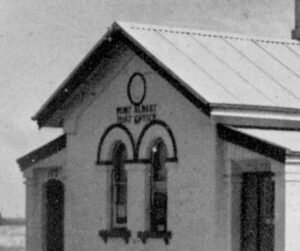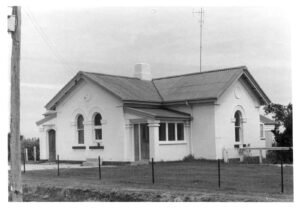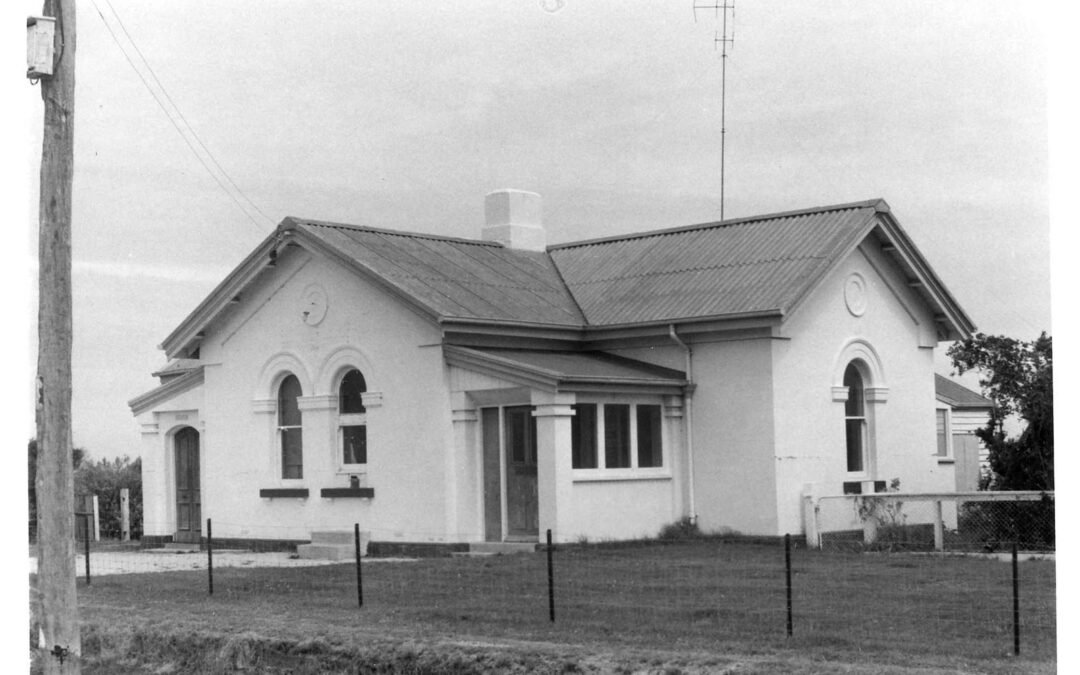On Wharf Street, overlooking the wharf, stands one of Port Albert’s most recognisable landmarks – the former Post and Telegraph Office. Built in 1864, it served the community for more than a century and is recognised as the oldest surviving post office in Gippsland and among the earliest still standing in Victoria.
Its simple, symmetrical form and arched windows give it quiet authority. In a town once built mostly of timber and corrugated iron, this solid brick and bluestone building represented permanence – a statement that Port Albert had become a place of consequence.
Preserving a Local Landmark
The post office closed in 1972 and was later sold by Australia Post. Unlike many rural post offices that were demolished or heavily altered, Port Albert’s survived largely intact. Its early recognition by the National Trust of Australia (Victoria) in 1970, followed by inclusion on the Victorian Heritage Register (Hermes No. 70028), helped secure its protection.
 Today it remains a private residence, carefully restored and adapted for modern use. More recent owners have retained its defining features – high ceilings, arched windows, Baltic pine floors, and solid brickwork – while adding an accommodation wing at the rear. The building sits within a 1,597 square-metre block overlooking the historic Government Wharf, its courtyard shaded by mature trees.
Today it remains a private residence, carefully restored and adapted for modern use. More recent owners have retained its defining features – high ceilings, arched windows, Baltic pine floors, and solid brickwork – while adding an accommodation wing at the rear. The building sits within a 1,597 square-metre block overlooking the historic Government Wharf, its courtyard shaded by mature trees.
This sensitive reuse reflects the principles of the Burra Charter, which emphasises ongoing use as the best form of conservation. By keeping the building lived in, Port Albert has preserved not only its structure but also its connection to the community.
A Port Built on Communication
When the post office was constructed in 1864, Port Albert was Gippsland’s main seaport. Everything – settlers, livestock, goods, and mail – arrived by sea. Before the railway reached inland towns, ships brought the world to this remote edge of the colony.
Postal services had operated here since the 1840s, first from makeshift premises, then from a small timber office. The new brick building, combining postal and telegraph functions, signalled a shift from provisional settlement to permanence. It also coincided with the arrival of the telegraph line, which reached Port Albert that same year, linking the town to Melbourne in hours rather than days.
For local residents, the building represented progress. It was where shipping news arrived, government payments were made, and families collected letters from the other side of the world. The rhythm of life often turned on its deliveries – a reminder that communication, as much as trade, sustained the district.
Design and Craftsmanship
 The Port Albert post office was built in a conservative Italianate style, a restrained interpretation of the architecture popular in Melbourne during the 1860s. Its symmetrical façade, bracketed eaves, and tall arched windows gave the small coastal town a touch of metropolitan civility.
The Port Albert post office was built in a conservative Italianate style, a restrained interpretation of the architecture popular in Melbourne during the 1860s. Its symmetrical façade, bracketed eaves, and tall arched windows gave the small coastal town a touch of metropolitan civility.
Constructed from locally fired brick with bluestone detailing, the building contrasted sharply with the surrounding weatherboard cottages. Inside, the plan followed a typical layout of the period: a public office at the front, living quarters at the rear, and a telegraph room attached. No record survives of its architect, though its proportions and detailing suggest it was designed through the Public Works Department – one of a series of standardised yet regionally adapted buildings produced for frontier settlements.
The use of durable materials reflected both confidence and necessity. The coastal environment demanded strength, and the government wanted longevity for what it saw as essential infrastructure. A building of this quality in a town of fewer than 500 people made a clear statement about Port Albert’s standing in the colony.
The Telegraph Era
The opening of the telegraph service transformed communication across Gippsland. Operators at Port Albert tapped messages to and from Sale, Alberton, and Melbourne, reporting shipping movements, weather, and emergencies. Telegrams Australia records it among the earliest telegraph offices in the region.
The system turned the post office into a communications hub – a single-room link between a remote district and the capital. Within months of its opening, it was handling everything from maritime news to government dispatches. The speed of information changed how the community functioned; decisions that once took weeks could now be made in hours.
Decline and Endurance
 Port Albert’s prosperity peaked in the 1860s. As railways reached inland towns, trade routes shifted, and larger ships bypassed the shallow inlet. The port declined, but the post office endured.
Port Albert’s prosperity peaked in the 1860s. As railways reached inland towns, trade routes shifted, and larger ships bypassed the shallow inlet. The port declined, but the post office endured.
For more than a hundred years, residents came here for their letters, pensions, and newspapers. By the mid-20th century, the building remained largely unaltered – a functional public office with a distinctive sense of place. Photographs from 1949 show the same brick façade, the same view across the harbour, and the same quiet reliability it offered from the beginning.
When it finally closed in 1972, the closure marked the end of an era rather than a loss. The building passed into private hands but continued to serve the town in a different way – as a reminder of how central communication once was to daily life.
Part of a Larger Story
The former post office is one of several surviving nineteenth-century civic and government-era buildings in the Wharf Street precinct, standing alongside the former Bank of Victoria (now the Maritime Museum), the former Customs House site, and the historic Government Wharf with its early sheds and maritime structures.
Within a state context, only a handful of comparable post offices from the 1860s survive largely intact – among them those at Camperdown (1863), Heathcote (1861), and Port Fairy (1868). Port Albert’s building therefore represents one of the earliest regional examples still in use, and the only one of its age remaining in Gippsland.
Its continued presence demonstrates how architectural conservation often relies on community pride. Local ownership, early recognition, and practical reuse have protected the building more effectively than legislation alone.
 An Enduring Connection
An Enduring Connection
Viewed from the harbour road, the former post office looks much as it did 160 years ago. The brickwork has weathered, but the proportions remain the same. It stands as both a home and a local landmark – not a museum piece, but a working part of the town’s fabric.
The building’s survival mirrors Port Albert’s own story: shaped by the tides of commerce and change, yet sustained by care and continuity. It reminds us that heritage is not only about preserving the past, but about maintaining the structures that continue to tell it.
In Port Albert, the old post office does just that – a quiet witness to how this coastal town once reached out to the world, and how it still keeps that connection alive.
References
- Victorian Heritage Database, Hermes No. 70028, Former Port Albert Post Office
- National Trust of Australia (Victoria), File FN 2732 (1970)
- Graeme Butler, Port Albert Conservation Study (1982)
- Guidelines for the Assessment of Heritage Planning Applications: Port Albert & District (Wellington Shire, 2002)
- Telegrams Australia, Telegraph Offices: Gippsland South
- Kenneth Cox, Land of the Pelican: The Story of Yarram and District (1982)
 The couple later moved to Bruthen Station, a site of significant historical trauma where the indigenous GunaiKurnai people suffered one of the region’s worst massacres. The Buntines moved there some 3-4 years after the massacres but their relationship with the GunaiKurnai was recognised to be “checkered”, as was sadly the case with most white settlers at the time.
The couple later moved to Bruthen Station, a site of significant historical trauma where the indigenous GunaiKurnai people suffered one of the region’s worst massacres. The Buntines moved there some 3-4 years after the massacres but their relationship with the GunaiKurnai was recognised to be “checkered”, as was sadly the case with most white settlers at the time. Today it remains a private residence, carefully restored and adapted for modern use. More recent owners have retained its defining features – high ceilings, arched windows, Baltic pine floors, and solid brickwork – while adding an accommodation wing at the rear. The building sits within a 1,597 square-metre block overlooking the historic Government Wharf, its courtyard shaded by mature trees.
Today it remains a private residence, carefully restored and adapted for modern use. More recent owners have retained its defining features – high ceilings, arched windows, Baltic pine floors, and solid brickwork – while adding an accommodation wing at the rear. The building sits within a 1,597 square-metre block overlooking the historic Government Wharf, its courtyard shaded by mature trees. The Port Albert post office was built in a conservative Italianate style, a restrained interpretation of the architecture popular in Melbourne during the 1860s. Its symmetrical façade, bracketed eaves, and tall arched windows gave the small coastal town a touch of metropolitan civility.
The Port Albert post office was built in a conservative Italianate style, a restrained interpretation of the architecture popular in Melbourne during the 1860s. Its symmetrical façade, bracketed eaves, and tall arched windows gave the small coastal town a touch of metropolitan civility. Port Albert’s prosperity peaked in the 1860s. As railways reached inland towns, trade routes shifted, and larger ships bypassed the shallow inlet. The port declined, but the post office endured.
Port Albert’s prosperity peaked in the 1860s. As railways reached inland towns, trade routes shifted, and larger ships bypassed the shallow inlet. The port declined, but the post office endured. An Enduring Connection
An Enduring Connection


